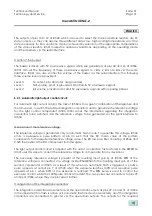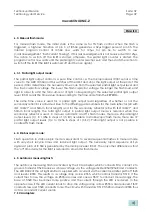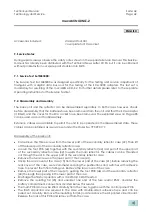
Technik und Service
Seite: 39
Technology and Service
Page: 39
mecablitz 40 MZ-2
ENGLISH
6.3. Manual flash mode:
For manual flash mode, the initial state is the same as for TTL flash control. When the flash is
triggered, a high-low transition at pin 3 of IC504 generates a 32µs trigger pulse at pin 35. The
internal program control of IC504 now waits for 125µs for pin 34 to switch to low
(=acknowledgement "flash current flowing"). If this acknowledgement is not received within 125µs,
the action to switch off the IGBT is started; otherwise, the partial light counter is started. The
program control now waits until the partial light counter reaches zero and then starts the action to
switch off the IGBT (the IGBT is switched off and then on again).
6.3.1. Partial light output mode:
The partial light output control is a pure time control, i.e. the microprocessor IC301 sends a time
value to the ASIC IC504 and this switches off the IGBT and stops the light output at the end of this
period. IC301 determines the necessary time code from the selected partial light output level and
the flash capacitor voltage. The lower the flash capacitor voltage, the longer the flash must emit
light in order to emit the total amount of light corresponding to the selected partial light output
level. IC301 reads the time value corresponding to the time code from the EEPROM.
The same time value is used for a partial light output level regardless of whether or not the
secondary reflector is activated. Due to the differing guide numbers for the main reflector (40 with
ISO 100/21° and 50mm focal length) and for the secondary reflector (28 with ISO 100/21° and
50mm focal length), the total light output in partial light output mode is reduced when the
secondary reflector is used. In manual, automatic and TTL flash modes, there are 25 partial light
output levels (1/1 to 1/256 in steps of 1/3 EV) available. In stroboscopic flash mode, there are 19
partial light output levels (1/4 to 1/256 in steps of 1/3 EV). Partial light output is not possible in
cordless TTL flash mode.
6.4. Stroboscopic mode:
Flash operation in stroboscopic mode is equivalent to several sequential flashes in manual mode
with very short recycle times and reduced light output. The necessary rapid sequence of Syn
signals at pin 3 of IC504 is generated by the microprocessor IC301. The only other difference is that
the "off" time delay for the IGBT is reduced to 4ms in this flash mode.
6.5. Autofocus measuring flash:
The autofocus measuring flash is activated by the SCA adapter, which connects SCA contact 2 to
ground. Transistor Tr520 receives a base voltage via the voltage divider R547/R548 and conducts.
The LED D002 of the AF light emitter is supplied with a current via the collector-emitter path of Tr520
and resistor R555. This results in a voltage drop across R555, which controls transistor Tr519. If the
current tries to rise, the voltage on R555 also rises and causes Tr519 to conduct more strongly. The
base of Tr520 thus becomes more positive and the current through the LED is reduced. In the
opposite case, if the LED current tends to drop, the voltage drop across R555 is also reduced, Tr519
conducts less and Tr520 conducts more. The circuit with transistors Tr519, Tr520 and resistor R555 thus
acts as a constant current source.
7. SCA adapters:





































